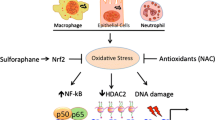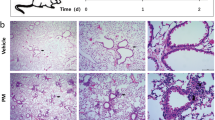Abstract
Particulate pollution is suspected to contribute to obstructive lung diseases characterized by chronic inflammation, mucus hypersecretion and bronchial remodeling. Our aim was to study the effect of real-world particulate matter (PM) on the expression of a mucin, MUC5AC, focusing on the role of the epidermal growth factor receptor (EGFR) pathway. MUC5AC induction was studied in vivo in mice trachea and in vitro in human bronchial epithelial cells (HBEC) exposed to urban fine PM. Fine PM were able to induce MUC5AC mRNA in mice trachea after 48 h of exposure (50 μg PM/mouse), and MUC5AC mRNA and protein in HBEC after 24 h of exposure (from 5 μg PM/cm2). It was associated with the increased expression of amphiregulin (AREG), an EGFR ligand. Experiments with conditioned media (media from PM-treated cells) demonstrated the involvement of AREG on MUC5AC induction as MUC5AC induction by media from PM-treated cells was prevented in the presence of either EGFR- or AREG-neutralizing antibodies. The effect of an inhibitor of a metalloprotease involved in the AREG shedding confirmed the autocrine loop made by AREG leading to MUC5AC induction by fine PM. We also demonstrated that IL-8 pro-inflammatory cytokine induction was dependent on the same autocrine mechanisms. We demonstrate for the first time that MUC5AC expression and production is increased by short-term exposure to fine PM through an autocrine effect of AREG. Our study provides mechanistic explanations to the exacerbation of obstructive lung diseases induced by particulate pollution characterized by mucus hypersecretion and chronic inflammation.







Similar content being viewed by others
References
Auger F, Gendron MC, Chamot C, Marano F, Dazy AC (2006) Responses of well-differentiated nasal epithelial cells exposed to particles: role of the epithelium in airway inflammation. Toxicol Appl Pharmacol 215(3):285–294
Baulig A, Poirault JJ, Ausset P, Schins R, Shi T, Baralle D, Dorlhene P, Meyer M, Lefevre R, Baeza-Squiban A, Marano F (2004) Physicochemical characteristics and biological activities of seasonal atmospheric particulate matter sampling in two locations of Paris. Environ Sci Technol 38(22):5985–5992
Blanchet S, Ramgolam K, Baulig A, Marano F, Baeza-Squiban A (2004) Fine particulate matter induces amphiregulin secretion by bronchial epithelial cells. Am J Respir Cell Mol Biol 30(4):421–427
Bonner JC (2002) The epidermal growth factor receptor at the crossroads of airway remodeling. Am J Physiol Lung Cell Mol Physiol 283(3):L528–L530
Burgel PR, Nadel JA (2008) Epidermal growth factor receptor-mediated innate immune responses and their roles in airway diseases. Eur Respir J 32(4):1068–1081
Churg A, Brauer M, Avila-Casado MD, Fortoul TI, Wright JL (2003) Chronic exposure to high levels of particulate air pollution and small airway remodeling. Environ Health Perspect 111(5):714-718
de Boer WI, Hau CM, van Schadewijk A, Stolk J, van Krieken JH, Hiemstra PS (2006) Expression of epidermal growth factors and their receptors in the bronchial epithelium of subjects with chronic obstructive pulmonary disease. Am J Clin Pathol 125(2):184–192
Enomoto Y, Orihara K, Takamasu T, Matsuda A, Gon Y, Saito H, Ra C, Okayama Y (2009) Tissue remodeling induced by hypersecreted epidermal growth factor and amphiregulin in the airway after an acute asthma attack. J Allergy Clin Immunol 124(5):913–920.e911–917
Harkema JR, Keeler G, Wagner J, Morishita M, Timm E, Hotchkiss J, Marsik F, Dvonch T, Kaminski N, Barr E (2004) Effects of concentrated ambient particles on normal and hypersecretory airways in rats. Res Rep Health Eff Inst 120:1–68; (discussion 69–79)
Kim KW, Jee HM, Park YH, Choi BS, Sohn MH, Kim KE (2009) Relationship between amphiregulin and airway inflammation in children with asthma and eosinophilic bronchitis. Chest 136(3):805–810
Le Cras TD, Acciani TH, Mushaben EM, Kramer EL, Pastura PA, Hardie WD, Korfhagen TR, Sivaprasad U, Ericksen M, Gibson AM, Holtzman MJ, Whitsett JA, Hershey GK (2011) Epithelial EGF receptor signaling mediates airway hyperreactivity and remodeling in a mouse model of chronic asthma. Am J Physiol Lung Cell Mol Physiol 300(3):L414–L421
Li N, Hao M, Phalen R, Hinds W, Nel A (2003) Particulate air pollutants and asthma. A paradigm for the role of oxidative stress in PM-induced adverse health effects. Clin Immunol 109(3):250–265
Longphre M, Li D, Li J, Matovinovic E, Gallup M, Samet JM, Basbaum CB (2000) Lung mucin production is stimulated by the air pollutant residual oil fly ash. Toxicol Appl Pharmacol 162(2):86–92
Mazzoli-Rocha F, Fernandes S, Einicker-Lamas M, Zin W (2010) Roles of oxidative stress in signaling and inflammation induced by particulate matter. Cell Biol Toxicol 26(5):481–498
Newland N, Richter A (2008) Agents associated with lung inflammation induce similar responses in NCI-H292 lung epithelial cells. Toxicol in Vitro 22(7):1782–1788
Pope CA, Burnett RT, Krewski D, Jerrett M, Shi Y, Calle EE, Thun MJ (2009) Cardiovascular mortality and exposure to airborne fine particulate matter and cigarette smoke: shape of the exposure-response relationship. Circulation 120(11):941–948
Puddicombe SM, Polosa R, Richter A, Krishna MT, Howarth PH, Holgate ST, Davies DE (2000) Involvement of the epidermal growth factor receptor in epithelial repair in asthma. FASEB J 14(10):1362–1374
Ramgolam K, Hamel R, Rumelhard M, Marano F, Baeza-Squiban A (2012) Autocrine effect of EGFR ligands on the pro-inflammatory response induced by PM(2.5) exposure in human bronchial epithelial cells. Arch Toxicol
Robinson CL, Baumann LM, Romero K, Combe JM, Gomez A, Gilman RH, Cabrera L, Gonzalvez G, Hansel NN, Wise RA, Barnes KC, Breysse PN, Checkley W (2011) Effect of urbanisation on asthma, allergy and airways inflammation in a developing country setting. Thorax 66(12):1051–1057
Rogers DF (2007) Physiology of airway mucus secretion and pathophysiology of hypersecretion. Respir Care 52(9):1134–1146; (discussion 1146–1139)
Rumelhard M, Ramgolam K, Auger F, Dazy AC, Blanchet S, Marano F, Baeza-Squiban A (2007a) Effects of PM2.5 components in the release of amphiregulin by human airway epithelial cells. Toxicol Lett 168(2):155–164
Rumelhard M, Ramgolam K, Hamel R, Marano F, Baeza-Squiban A (2007b) Expression and role of EGFR ligands induced in airway cells by PM2.5 and its components. Eur Respir J 30(6):1064–1073
Shao MX, Nadel JA (2005) Neutrophil elastase induces MUC5AC mucin production in human airway epithelial cells via a cascade involving protein kinase C, reactive oxygen species, and TNF-alpha-converting enzyme. J Immunol 175(6):4009–4016
Shao MX, Ueki IF, Nadel JA (2003) Tumor necrosis factor alpha-converting enzyme mediates MUC5AC mucin expression in cultured human airway epithelial cells. Proc Natl Acad Sci USA 100(20):11618–11623
Shao MX, Nakanaga T, Nadel JA (2004) Cigarette smoke induces MUC5AC mucin overproduction via tumor necrosis factor-alpha-converting enzyme in human airway epithelial (NCI-H292) cells. Am J Physiol Lung Cell Mol Physiol 287(2):L420–L427
Takeyama K, Dabbagh K, Lee HM, Agustí C, Lausier JA, Ueki IF, Grattan KM, Nadel JA (1999) Epidermal growth factor system regulates mucin production in airways. Proc Natl Acad Sci USA 96(6):3081–3086
Val S, Martinon L, Cachier H, Yahyaoui A, Marfaing H, Baeza-Squiban A (2011) Role of size and composition of traffic and agricultural aerosols in the molecular responses triggered in airway epithelial cells. Inhal Toxicol 23(11):627–640
Vestbo J (2005) Chronic mucus hypersecretion, exacerbations and natural history of COPD. Exp Lung Res 31(Suppl 1):63–65
Yoshizaki K, Brito JM, Toledo AC, Nakagawa NK, Piccin VS, Junqueira MS, Negri EM, Carvalho AL, Oliveira AP, Lima WT, Saldiva PH, Mauad T, Macchione M (2010) Subchronic effects of nasally instilled diesel exhaust particulates on the nasal and airway epithelia in mice. Inhal Toxicol 22(7):610–617
Acknowledgments
This work was supported by Agence Nationale pour la Recherche (ANR) Megatox (ANR CESA 2008-009-02), ADEME and ANSES French environmental agencies for Val S. PhD funding. ANSES also supported Belade E. PhD funding. Jorge Boczkowski was supported by a “Contrat Hospitalier de Recherche Translationnelle” (Inserm—APHP). The authors want to thank the Jacques Monod Institute (IJM, Paris, France) for the use of Genomic facility and Flow Cytometry facility with the help of Nicole Boggetto.
Conflict of interest
The authors declare no conflicts of interest.
Author information
Authors and Affiliations
Corresponding author
Electronic supplementary material
Below is the link to the electronic supplementary material.
Rights and permissions
About this article
Cite this article
Val, S., Belade, E., George, I. et al. Fine PM induce airway MUC5AC expression through the autocrine effect of amphiregulin. Arch Toxicol 86, 1851–1859 (2012). https://doi.org/10.1007/s00204-012-0903-6
Received:
Accepted:
Published:
Issue Date:
DOI: https://doi.org/10.1007/s00204-012-0903-6




